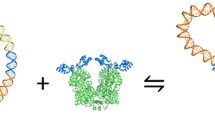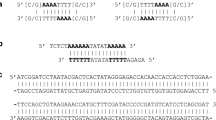Abstract
The discovery of circular DNA, over 30 years ago, introduced an element of uneasiness in what had been, up to that point, the almost picture-perfect story of the elucidation of the molecular biology of heredity. If DNA indeed has the Watson-Crick right-handed helical secondary structure, then in circular DNA, thousands, or perhaps even millions of twists must be removed in each generation, and re-wound in the next generation.
Although enzyme systems adequate for this task have long since been found and characterized, there have nevertheless arisen a number of proposals for alternative DNA structures in which the strands are topologically non-linked, so that they might separate during replication without having to be unwound. These structures have generally been put forth as theory only, and have been largely unaccompanied by experimental evidence to support their applicability to native DNA from living systems.
Recently, however, a report has emerged suggesting that it might be possible to separate, intact, the individual single-stranded circular half-chromosomes which constitute the double-stranded circular chromosomes of certain plasmids. This would not be possible unless the chromosomes had one of the alternative, topologically non-linked structures.
It is widely believed that after a half-century of worldwide DNA research, any significant change to the Watson-Crick structure is unlikely to stand up to scrutiny. Nevertheless, the present author has found that in many instances in which the behavior of circular duplex DNA is considered to be explicable only in terms of the topologically linked helical model, it is also possible to explain that same behavior in terms of a topologically non-linked model. It is necessary, in these instances, to make certain logical assumptions which cannot be conclusively proven at the present time.
The author herein offers an example of one such instance, namely an examination of the behavior of circular duplex DNA in an alkaline titration experiment, where conformational changes in DNA are deduced from changes in its buoyant density at pH’s between 7 and 14. These data have been explained in terms of topological linkage between the DNA strands, but they can also be explained without invoking any such topological linkage, provided that the above-mentioned logical assumptions can be accepted.
The principles which emerge from this are applicable to other settings in which knowledge of the topology of DNA is critical to the understanding of observed phenomena.
Similar content being viewed by others
References
Casey, J. and N. Davidson (1977). Rates of formation and thermal stabilities of RNA:DNA and DNA:DNA duplexes at high concentrations of formamide. Nucleic Acids Res. 4, 1539–1552.
Crick, F. H.C., J. C. Wang and W. R. Bauer (1979). Is DNA really a double helix? J. Mol. Biol. 129, 449–461.
Day, L. A., R. L. Wiseman and C. J. Marzec (1979). Structure models for DNA in filamentous viruses with phosphates near the center. Nucleic Acids Res. 7, 1393–1403.
Glaubiger, D. and J. E. Hearst (1967). Effect of superhelical structure on the secondary structure of DNA rings. Biopolymers 5, 691–696.
Ikehara, M., S. Uesugi and J. Yano (1972). Left-handed helical polynucleotides with d-sugar phosphodiester backbones. Nat. New Biol. 240, 16, 17.
Jaenisch, R., A. Mayer and A. Levine (1971). Replicating SV40 molecules containing closed circular template DNA strands. Nat. New Biol. 233, 72–75.
Kang, C., I. Berger, C. Lockshin, R. Ratliff, R. Moyzis and A. Rich (1994). Crystal structure of intercalated four-stranded d(C3T) at 1.4 angstrom resolution. Proc. Natl. Acad. Sci. USA 91, 11636–11640.
Kang, C., I. Berger, C. Lockshin, R. Ratliff, R. Moyzis and A. Rich (1995). Stable loop in the crystal structure of the intercalated four-stranded cytosine-rich metazoan telomere. Proc. Natl. Acad. Sci. USA 92, 3874–3878.
Liu, D. J. and L. A. Day (1994). Pf1 virus structure: helical coat protein and DNA with paraxial phosphates. Science 265, 671–674.
Mercado, C. M. and M. Tomasz (1977). Circular dichroism of mitomycin-DNA complexes. Evidence for a conformational change in DNA. Biochemistry 16, 2040–2046.
Mitsui, Y., R. Langridge, B. E. Shortle, C. R. Cantor, R. C. Grant, M. Kodama and R. D. Wells (1970). Physical and enzymatic studies on poly d(I-C)·poly d(I-C), an unusual double-helical DNA. Nature 228, 1166–1169.
Nordheim, A., M. L. Pardue, E. M. Lafer, A. Möller, B. D. Stollar and A. Rich (1981). Antibodies to left-handed Z-DNA bind to interband regions of Drosophila polytene chromosomes. Nature 294, 417–422.
Pauling, L. and R. B. Corey (1953). A proposed structure for the nucleic acids. Proc. Natl. Acad. Sci. USA 39, 84–97.
Pohl, F. M. (1976). Polymorphism of a synthetic DNA in solution. Nature 260, 365–366.
Pohl, F. M. and T. M. Jovin (1972). Salt-induced co-operative conformational change of a synthetic DNA: equilibrium and kinetic studies with poly(dG-dC). J. Mol. Biol. 67, 375–396.
Rodley, G. A., R. S. Scobie, R. H.T. Bates and R. M. Lewitt (1976). A possible conformation for double-stranded polynucleotides. Proc. Natl. Acad. Sci., USA 73, 2959–2963.
Rush, M. G. and R. C. Warner (1970). Alkali denaturation of covalently closed circular duplex deoxyribonucleic acid. J. Biol. Chem. 245, 2704–2708.
Sasisekharan, V., N. Pattabiraman, and G. Gupta (1978). Some implications of an alternative structure for DNA. Proc. Natl. Acad. Sci. USA 75, 4092–4096.
Sebring, E. D., T. J. Kelly Jr, M. M. Thoren and N. P Salzman (1971). Structure of replicating Simian Virus 40 deoxyribonucleic acid molecules. J. Virol. 8, 478–490.
Shure, M. and J. Vinograd (1976). The number of superhelical turns in native virion SV40 DNA and Minicol DNA determined by the band counting method. Cell 8, 215–226.
Stettler, U. H., H. Weber, T. Koller and Ch. Weissmann (1979). Preparation and characterization of form V DNA, the duplex DNA resulting from association of complementary, circular single-stranded DNA. J. Mol. Biol. 131, 21–40.
Strider, W. (1971). Denatured replicative form and complex DNA of φX174: isolation, renaturation, and sedimentation properties, PhD Thesis, Department of Biochemistry, New York University School of Medicine, First Avenue, New York, NY 10016, U.S.A.
Strider, W. and R. C. Warner (1971). Denatured replicative form and complex DNA of φX174: isolation and renaturation. Fed. Proc. Fed. Amer. Soc. Exp. Biol. 30, 1053.
Strider, W., M. N. Camien and R. C. Warner (1981). Renaturation of denatured, covalently closed circular DNA. J. Biol. Chem. 256, 7820–7829.
Travers, F., A. M. Michelson and P. Douzou (1970). Conformational changes of nucleic acids in methanol-water solutions at low temperature. Biochim. Biophys. Acta 217, 1–6.
Vinograd, J., J. Lebowitz and R. Watson (1968). Early and late helix-coil transitions in closed circular DNA. The number of superhelical turns in Polyoma DNA. J. Mol. Biol. 33, 173–197.
Vinograd, J., J. Lebowitz, R. Radloff, R. Watson and P. Laipis (1965). The twisted circular form of polyoma viral DNA. Proc. Natl. Acad. Sci. USA 53, 1104–1111.
Wang, A. H. J., G. J. Quigley, F. J. Kolpak, J. L. Crawford, J. H. Van Boom, G. Van Der Marel and A. Rich (1979). Molecular structure of a left-handed double helical DNA fragment at atomic resolution. Nature 282, 680–686.
Wu, R and T. T. Wu (1996). A novel intact circular dsDNA supercoil. Bull. Math. Biol 58, 1171–1185.
Zimmer, C. and G. Luck (1974). Conformation and reactivity of DNA. IV. Circular dichroism studies of salt-induced conformational changes of DNAs of different base composition. Biochim. Biophys. Acta 361, 11–32.
Author information
Authors and Affiliations
Rights and permissions
About this article
Cite this article
Biegeleisen, K. Topologically non-linked circular duplex DNA. Bull. Math. Biol. 64, 589–609 (2002). https://doi.org/10.1006/bulm.2002.0288
Received:
Accepted:
Issue Date:
DOI: https://doi.org/10.1006/bulm.2002.0288




